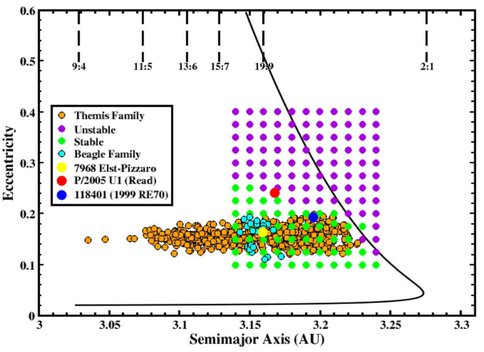2009 Annual Science Report
 University of Hawaii, Manoa
Reporting | JUL 2008 – AUG 2009
University of Hawaii, Manoa
Reporting | JUL 2008 – AUG 2009
Main Belt Comet Origin, Formation and Activation
Project Summary
Main Belt Comets are a new class of objects that have recently been detected in the asteroid belt. These objects carry sub-surface water ice that may have played an important role in the delivery of water to the Earth. This project aims to understand the origin of MBCs, their contribution to Earth’s water budget, and the regions in the asteroid belt where many of these bodies can be found.
Project Progress
The recent discovery of three icy asteroids with comet-like appearance has suggested that a new class of objects known as Main Belt Comets may exist in the asteroid belt. These water-carrying asteroids could have played an important role in the delivery of water to the Earth. Haghighipour has an expansive and on-going project on the formation and dynamics of MBCs. Haghighipour’s research has shown that MBCs have formed in-situ, as members of asteroid families (e.g., Themis family), in the outer half of the asteroid belt. The results of his simulations have confirmed the idea that the comet-like activities of MBCs are due to the sublimation of subsurface water ice that has been exposed after small meter-sized objects hit MBCs. Haghighipour’s simulations have also made predictions of the regions where these objects have high probability of detection (figure 1). In general asteroid families with large hydrated parent bodies capable of differentiation are the most favorable places, although interactions with giant planets may scatter MBCs to isolated orbits elsewhere in the asteroid belt as well. Haghighipour has also been involved in the discovery of the fourth MBC, which was announced earlier this year in a paper in the Astronomical Journal co-authored with Jewitt, and Yang. In regard to the origin of Earth’s water, MBCs, as water-carrying asteroids, are of particular importance since their small sizes makes them easy to be scattered to other regions of the asteroid belt. Haghighipour’s simulations portray a coherent picture of the scattering of these objects and their contributions to water on the Earth.
Graph of the stability of hypothetical MBCs in terms of their eccentricities. The orange circles show the Themis family and the ones in Cyan are the Beagle family of asteroids. The solid line show the region of the 2:1 MMR with Jupiter. Each circle represents the initial orbital elements of a hypothetical MBC. Circles in green correspond to stable ones whereas those in purple show instability. As shown here, stable MBCs are clustered around Themis family implying that large asteroid families may be potential places for detecting more MBCs.
Publications
- Haghighipour, N. (2008). Dynamical Constraints on the Origin and Activation Mechanism of Main Belt Comets. Asteroids, Comets, Meteors 2008. Baltimore, MD.
-
PROJECT INVESTIGATORS:
-
RELATED OBJECTIVES:
Objective 1.1
Formation and evolution of habitable planets.



